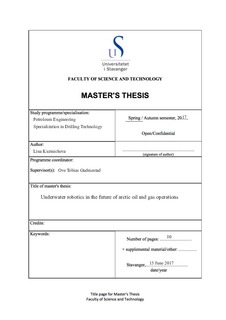| dc.contributor.advisor | Gudmestad, Ove Tobias | |
| dc.contributor.author | Kuzmicheva, Lina | |
| dc.coverage.spatial | Arctic, Svalbard | nb_NO |
| dc.date.accessioned | 2017-10-24T11:57:01Z | |
| dc.date.available | 2017-10-24T11:57:01Z | |
| dc.date.issued | 2017-06-15 | |
| dc.identifier.uri | http://hdl.handle.net/11250/2461812 | |
| dc.description | Master's thesis in Petroleum engineering | nb_NO |
| dc.description.abstract | Arctic regions have lately been in the centre of increasing attention due to high vulnerability to climate change and the retreat in sea ice cover. Commercial actors are exploring the Arctic for new shipping routes and natural resources while scientific activity is being intensified to provide better understanding of the ecosystems. Marine surveys in the Arctic have traditionally been conducted from research vessels, requiring considerable resources and involving high risks where sea ice is present. Thus, development of low-cost methods for collecting data in extreme areas is of interest for both industrial purposes and environmental management.
The main objective of this thesis is to investigate the use of underwater vehicles as sensor platforms for oil and gas industry applications with focus on seabed mapping and monitoring. Theoretical background and a review of relevant previous studies are provided prior to presentation of the fieldwork, which took place in January 2017 in Kongsfjorden (Svalbard). The fieldwork was a part of the Underwater Robotics and Polar Night Biology course offered at the University Centre in Svalbard. Applied unmanned platforms included remotely operated vehicles (ROVs), autonomous underwater vehicles (AUVs) and an autonomous surface vehicle (ASV). They were equipped with such sensors as side-scan sonar, multi-beam echo sounder, camera and others. The acquired data was processed and used to provide information about the study area.
The carried out analysis of the vehicle performance gives an insight into challenges specific to marine surveys in the Arctic regions, especially during the period of polar night. The discussion is focused on the benefits of underwater robotics and integrated platform surveying in remote and harsh environment. Recommendations for further research and suggestions for application of similar vehicles and sensors are also given in the thesis. | nb_NO |
| dc.language.iso | eng | nb_NO |
| dc.publisher | University of Stavanger, Norway | nb_NO |
| dc.relation.ispartofseries | Masteroppgave/UIS-TN-IPT/2017; | |
| dc.rights | Attribution-NonCommercial-NoDerivatives 4.0 Internasjonal | * |
| dc.rights.uri | http://creativecommons.org/licenses/by-nc-nd/4.0/deed.no | * |
| dc.subject | petroleumsteknologi | nb_NO |
| dc.subject | petroleum engineering | nb_NO |
| dc.subject | undervannsteknologi | nb_NO |
| dc.title | Underwater robotics in the future of arctic oil and gas operations | nb_NO |
| dc.type | Master thesis | nb_NO |
| dc.subject.nsi | VDP::Teknologi: 500::Berg‑ og petroleumsfag: 510::Petroleumsteknologi: 512 | nb_NO |

